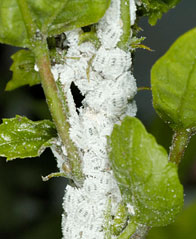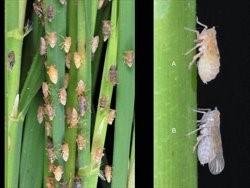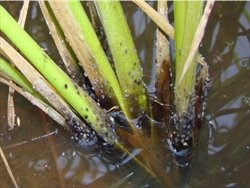 If you have been seeing small flies or gnats in your kitchen, they’re probably fruit flies. These pesky pests can be found throughout the world, in homes, gardens, warehouse, grocery stores, wineries, restaurants etc. They are readily attached to any number of materials, especially that of moisture. Fruit flies can be a problem year-round but are especially common during late summer/fall because they are attracted to ripened or fermenting fruits and vegetables.
If you have been seeing small flies or gnats in your kitchen, they’re probably fruit flies. These pesky pests can be found throughout the world, in homes, gardens, warehouse, grocery stores, wineries, restaurants etc. They are readily attached to any number of materials, especially that of moisture. Fruit flies can be a problem year-round but are especially common during late summer/fall because they are attracted to ripened or fermenting fruits and vegetables.
But they also will breed in drains, garbage disposals, empty bottles and cans, trash containers, mops and cleaning rags. Hence, they also cause various bacterial diseases.
Fruit flies damage the larger proportion of agricultural production and even to crops grown in the gardens which are susceptible to attack by fruit flies. Commercial producers spend hundreds of millions of dollars on control measures and also suffered production losses.
Tomatoes, melons, squash, grapes and other perishable items are often the cause of an infestation. Fruit flies are also attracted to rotting bananas, potatoes, onions and other products.
You see, when a fruit is overripe or starts to go bad it begins to ferment, producing alcohol, which attracts fruit flies. They continue to gobble up the fermenting fruit, and in the process, lay hundreds of eggs which hatch into larvae in mere hours.
Female fruit fly lays their eggs into healthy, ripening fruit on the tree. Fruit flies lay their eggs up to 500 at a time!
 When the larvae hatch, they feed on the moist surface too. The entire life cycle from egg to adult takes only about eight to ten days so they proliferate with great rapidity.
When the larvae hatch, they feed on the moist surface too. The entire life cycle from egg to adult takes only about eight to ten days so they proliferate with great rapidity.
Many people are allergic to the bacteria carried by fruit flies, resulting in tiny red bumps on the skin.
The age has seen the worst fruit fly infestation like one mentioned below,
Worst fruit fly outbreak in five years
FEBRUARY 2 2015, The Border Mail
The Border region has been hit by its worse fruit fly outbreak in five years believed to be the result of unseasonal summer weather.
In the past few weeks, humidity has caused a proliferation of the fruit fly menace in Albury and Wodonga.
The increased number of Queensland fruit fly is also causing major problems for fruit growers at Cobram and Shepparton.
The fruit fly scourge is only a recent phenomenon in the Goulburn Valley.
Victorian Fruit Growers Association president Gary Godwil said it was a big issue last year, but it was worse this year.
Mr. Godwil said there was a significant expense involved in controlling the fly with the considerable time needed to apply control methods such as baiting.
“It is a big cost to the whole industry, a massive cost. I am baiting every 10 days,” he said.
Spoiled fruit is worth a lot of money and Mr. Godwil said it could not even be used for juice.
Fruit flies make Ghana mangoes unattractive worldwide
8th March 2013, Ghana Web
The dream of mango farmers in the country to go commercial particularly for export is marred by a huge challenge: this is because the prevalence of fruit-flies in many agro-ecological zones throughout the West African sub-region has resulted in the infestation of the fruit, making them unsuitable for the international market.
Mango in Ghana is targeted as the next non-traditional export crop that is expected to fetch the highest foreign exchange for the country and replace cocoa, but infestation by the fruit-flies has mostly caused rejection of mango consignments from Ghana-to the extent of sometimes imposing a ban on imports from Ghana.
The current insecticides are being used to control this menace. However besides being toxic and harmful insecticides kill the species. Repeated exposure to insecticides builds up resistance in insects until finally, the insecticide has little or no effect. Frequent insecticide applications make the problem worse.
C Tech Corporation offers a range of non-toxic, non-hazardous anti-insect aversive, which can be successfully used to keep pesky creatures at bay.
Our product – Combirepel™ can be easily described as insect aversive, used against all types of insects and which works on the mechanism of repellency. It means that it does not kill the target insects but only repel them, thus balancing the ecology and helping in maintaining the goal of sustainability.
Our product works on the mechanism of repellency. It temporarily inhibits the mating cycle of the insects. The product impairs the ability of the insects to reproduce, that is the insects will not lay eggs or the laid eggs will be infertile. The product causes feeding disruption in an insect by triggering an unpleasant reaction within the insect which might try to feed on the application. The product temporarily blocks the reproduction system of the insects by hindering the release of the vital hormones for growth.
Combirepel™ masterbatch can be incorporated in agricultural films, mulches, irrigation pipes, agricultural devices, and equipment while they are manufactured. The applications, when used with our products, will keep the pests like fruit-flies at a bay and thus will protect the agricultural produce from these pests.
Combirepel™ liquid concentrate can be mixed in paints in a pre-determined ratio and can be applied to the fencing and garbage bins. The interior and exterior of the houses, schools, hospitals, offices, warehouses, restaurants, food courts and pantries can be painted using our liquid concentrate.
Combirepel™ lacquer which can be applied as a topical application. The lacquer is compatible with most of the surfaces like metal, wood, concrete, polymer, ceramic etc. It can be applied to the already installed applications like pipes,
Combirepel™ is thermally stable and does not degrade on exposure to heat and sunlight. It does not kill or harm the insect but repels them. It does not volatilize and does not degrade the soil. It is RoHS, RoHS2, ISO, REACH, APVMA, NEA compliant and FIFRA exempted.
Contact us at technical.marketing@ctechcorporation.com to keep the pests away.
Also, visit our websites:
http://www.ctechcorporation.com/
http://www.rodrepel.com/
http://www.termirepel.com/
http://www.combirepel.com/
Follow our Facebook pages at:
1] https://www.facebook.com/Combirepel-411710912249274/
2] https://www.facebook.com/Termirepel-104225413091251/
3] https://www.facebook.com/Rodrepel-120734974768048/
Follow us on our Twitter pages at:
1] https://twitter.com/rodrepel
2] https://twitter.com/termirepel
3] https://twitter.com/combirepel






















